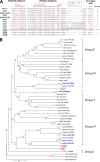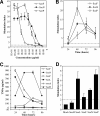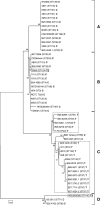Identification of three novel superantigen-encoding genes in Streptococcus equi subsp. zooepidemicus, szeF, szeN, and szeP
- PMID: 20713629
- PMCID: PMC2976332
- DOI: 10.1128/IAI.00751-10
Identification of three novel superantigen-encoding genes in Streptococcus equi subsp. zooepidemicus, szeF, szeN, and szeP
Abstract
The acquisition of superantigen-encoding genes by Streptococcus pyogenes has been associated with increased morbidity and mortality in humans, and the gain of four superantigens by Streptococcus equi is linked to the evolution of this host-restricted pathogen from an ancestral strain of the opportunistic pathogen Streptococcus equi subsp. zooepidemicus. A recent study determined that the culture supernatants of several S. equi subsp. zooepidemicus strains possessed mitogenic activity but lacked known superantigen-encoding genes. Here, we report the identification and activities of three novel superantigen-encoding genes. The products of szeF, szeN, and szeP share 59%, 49%, and 34% amino acid sequence identity with SPEH, SPEM, and SPEL, respectively. Recombinant SzeF, SzeN, and SzeP stimulated the proliferation of equine peripheral blood mononuclear cells, and tumor necrosis factor alpha (TNF-α) and gamma interferon (IFN-γ) production, in vitro. Although none of these superantigen genes were encoded within functional prophage elements, szeN and szeP were located next to a prophage remnant, suggesting that they were acquired by horizontal transfer. Eighty-one of 165 diverse S. equi subsp. zooepidemicus strains screened, including 7 out of 15 isolates from cases of disease in humans, contained at least one of these new superantigen-encoding genes. The presence of szeN or szeP, but not szeF, was significantly associated with mitogenic activity in the S. equi subsp. zooepidemicus population (P < 0.000001, P < 0.000001, and P = 0.104, respectively). We conclude that horizontal transfer of these novel superantigens from and within the diverse S. equi subsp. zooepidemicus population is likely to have implications for veterinary and human disease.
Figures




Similar articles
-
Prevalence and disease associations of superantigens szeF, szeN and szeP in the S. zooepidemicus population and possible functional redundancy of szeF.Res Vet Sci. 2014 Dec;97(3):481-7. doi: 10.1016/j.rvsc.2014.09.001. Epub 2014 Sep 16. Res Vet Sci. 2014. PMID: 25267286
-
Dissemination of the superantigen encoding genes seeL, seeM, szeL and szeM in Streptococcus equi subsp. equi and Streptococcus equi subsp. zooepidemicus.Vet Microbiol. 2005 Aug 10;109(1-2):135-41. doi: 10.1016/j.vetmic.2005.05.001. Vet Microbiol. 2005. PMID: 15953700
-
Characterization of pneumonia due to Streptococcus equi subsp. zooepidemicus in dogs.Clin Vaccine Immunol. 2010 Nov;17(11):1790-6. doi: 10.1128/CVI.00188-10. Epub 2010 Sep 22. Clin Vaccine Immunol. 2010. PMID: 20861329 Free PMC article.
-
Streptococcus equi: a pathogen restricted to one host.J Med Microbiol. 2011 Sep;60(Pt 9):1231-1240. doi: 10.1099/jmm.0.028233-0. Epub 2011 Jul 14. J Med Microbiol. 2011. PMID: 21757503 Review.
-
The pathogenic equine streptococci.Vet Res. 2004 Jul-Aug;35(4):397-409. doi: 10.1051/vetres:2004025. Vet Res. 2004. PMID: 15236673 Review.
Cited by
-
Exacerbated type II interferon response drives hypervirulence and toxic shock by an emergent epidemic strain of Streptococcus suis.Infect Immun. 2013 Jun;81(6):1928-39. doi: 10.1128/IAI.01317-12. Epub 2013 Mar 18. Infect Immun. 2013. PMID: 23509145 Free PMC article.
-
Transmission of Streptococcus equi subspecies zooepidemicus infection from horses to humans.Emerg Infect Dis. 2013 Jul;19(7):1041-8. doi: 10.3201/eid1907.121365. Emerg Infect Dis. 2013. PMID: 23777752 Free PMC article.
-
Pathogenicity Factors in Group C and G Streptococci.Microbiol Spectr. 2019 May;7(3):10.1128/microbiolspec.gpp3-0020-2018. doi: 10.1128/microbiolspec.GPP3-0020-2018. Microbiol Spectr. 2019. PMID: 31111818 Free PMC article. Review.
-
SpeS: A Novel Superantigen and Its Potential as a Vaccine Adjuvant against Strangles.Int J Mol Sci. 2020 Jun 23;21(12):4467. doi: 10.3390/ijms21124467. Int J Mol Sci. 2020. PMID: 32586031 Free PMC article.
-
Recurrent Streptococcus equi subsp. zooepidemicus Bacteremia in an Infant.J Clin Microbiol. 2015 Sep;53(9):3096-9. doi: 10.1128/JCM.01306-15. Epub 2015 Jul 15. J Clin Microbiol. 2015. PMID: 26179301 Free PMC article.
References
-
- Altschul, S. F., W. Gish, W. Miller, E. W. Myers, and D. J. Lipman. 1990. Basic local alignment search tool. J. Mol. Biol. 215:403-410. - PubMed
-
- Anzai, T., A. S. Sheoran, Y. Kuwamoto, T. Kondo, R. Wada, T. Inoue, and J. F. Timoney. 1999. Streptococcus equi but not Streptococcus zooepidemicus produces potent mitogenic responses from equine peripheral blood mononuclear cells. Vet. Immunol. Immunopathol. 67:235-246. - PubMed
-
- Arad, G., D. Hillman, R. Levy, and R. Kaempfer. 2001. Superantigen antagonist blocks Th1 cytokine gene induction and lethal shock. J. Leukoc. Biol. 69:921-927. - PubMed
-
- Artiushin, S. C., J. F. Timoney, A. S. Sheoran, and S. K. Muthupalani. 2002. Characterization and immunogenicity of pyrogenic mitogens SePE-H and SePE-I of Streptococcus equi. Microb. Pathog. 32:71-85. - PubMed
Publication types
MeSH terms
Substances
Associated data
- Actions
- Actions
- Actions
- Actions
- Actions
- Actions
- Actions
- Actions
- Actions
- Actions
- Actions
LinkOut - more resources
Full Text Sources
Medical
Molecular Biology Databases

